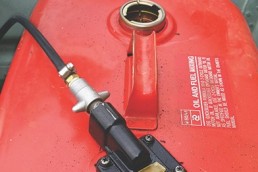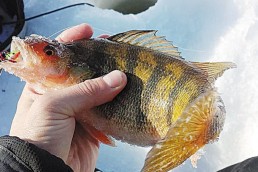Steps Toward Trouble-free Trailering
SHARE THIS POST
The saying, “An ounce of prevention is worth a pound of cure” is especially true when pulling a trailer. Taking a few simple precautions will save you a lot of money and time.
Ball mounts and leveling a trailer
There are two sizes for ball mounts: 1 1/4 by 1 1/4 and 2 by 2. If at all possible, install the larger size on your vehicle. You can always use a shim to go from large to small, if, for example, you have a small mount on your bike rack. But it is harder to go from small to large. Besides, the towing capacity would apply to the smaller size.
You want the tongue to be level with the road. If it’s too high or too low, problems can arise. You can get mounts that are straight to a 6-inch drop/rise. To get the right mount, put the tongue next to the receiver, making sure it is level. Measure any difference between the tongue and the receiver. This difference is the amount of drop you need in the ball mount.
Balance the load
The most common mistake most people make when loading a utility trailer is to put everything up front. This is especially true if you are carting only one thing. This usually puts too much weight on the tongue, which can overload the rear suspension. It also reduces the weight on the front tires, which can adversely affect steering and traction. Too little weight on the tongue will make the trailer track side to side and might cause it to fishtail out of control. In most cases, tongue weight should be only 10 to 15 percent of the weight of the trailer and the load. My little 4×8 trailer has only a 1,000-pound capacity, so if I have it loaded to the max, the tongue weight should only be about 110 +/-.
You could buy a $300 ball mount with a built-in scale, but baring that, you have to make an educated guess how much your back pumper drops. An easy, if not exact, method is to place a known load on the ball mount—say, a willing buddy of known weight—and measure how much the mount drops.
Ball and shank should fit the load
Most people know that there are two sizes of ball: 1 7/8 inches and 2 inches. While a 2-inch ball will not fit over a 1 7/8-inch ball, you could certainly put a 2-inch coupler over the 1 7/8th ball. But it is not recommended, so be aware of which size goes with which trailer if you tow more than one. Most people are not aware that trailer balls come with different-sized shanks: with 3/4-inch handles holding up to 3,500 pounds, ones at 1 inch with up to 7,500 pounds and those at 1 1/4 inches and above for 7,500 pounds. I always get the largest shank because the cost difference is negligible and then you don’t have to worry about overloading the shank. I prefer the shank attached to the ball verses a bolt, which screws into the ball.
Have a good jack on hand
Most people have a spare tire along, but don’t think about a jack. Over the years, car manufactures have decreased the quality of onboard jacks (or in the case of my wife’s new car, no jack at all), so you should try the one that comes with your vehicle. If it works fine you are good to go; if it doesn’t, get one that fits under the trailer frame and is easy to raise and lower. I like a scissor jack since it fits easily under my trailers and I don’t have to worry about the hydraulic fluid punking out on me.
Whenever I change tires or work on bearings I like to have the trailer attached to my vehicle. This way I don’t have to worry about it rolling away from me. If you don’t want to do this, make sure you have three tire chocks—two for the opposite wheel and one for the trailer jack.
Are you enjoying this post?
You can be among the first to get the latest info on where to go, what to use and how to use it!
In general, the bulk of the load is placed over the axle. I drill a series of holes along the top pieces of the sides of my trailer that accepts a 3/4-inch conduit. The conduit acts as a stop when I am carrying only a couple of things.
Always use a coupler pin
A coupler pin keeps the locking level from jiggling loose, causing your trailer to “get gone.” I like the type that has a spring clip rather than a cotter pin, which usually gets lost. Use some sturdy string to attach the pin to the trailer, that way you always have it with you.
On my boat trailer I have a locking pin. When I put the boat up for the day I always lock the coupler open. This does two things: If someone does try to abscond with my boat, he can’t lock it to his hitch, and second, I have to open the lock when I am hooking up, and then I know I have the key. One time I hooked up the trailer to my friend’s car, locked the pin and off we went, without the key. Since we were using his truck I didn’t have my keys or the extras that I always keep in the glove box. We had to drive everywhere for a couple days with the trailer since I couldn’t unlock the pin.
Check the coupler
Over time, the twisting and jostling of the coupler against the ball will wear it thin. On most trails the coupler is bolted on and can be easily replaced when worn or cracked. Greasing the ball can reduce wear, but it’s too messy.
Cross the safety chains Crossing or even twisting the chains keep them from bouncing on the road and wearing thin. When you hook the chains to the receiver, hook them from underneath. Some people use threaded links so they don’t have to worry about the chain(s) coming off. Just make sure it has enough load capacity in case the trailer does bounce loose.
Does your emergency brake work?
This only applies to large trailers and those with duel axles. Electric brakes are required on large trailers in most states. There are various systems, but basically they all apply the trailer brakes if it becomes separated from the towing vehicle. To test the system, hook everything up as you normally would and then physically pull the key that engages the breaks. With someone watching the trailer wheels, drive forward a little bit. If the brakes are working, the wheels will not turn. Read your owners manual to see how to fix the problem.
Bearing grease
Dry bearings are probably the number one cause for ending up on the side of the road. The general guideline is to repack the bearings every 10,000 miles. The problem is, who takes the time and effort and brain space to remember when you hit 10,000 miles? I do mine every three years, but I also have bearing caps with grease fittings. Some people are not fans of these or the spring-loaded caps, but I have used both without any problems.
Make a checklist
A checklist makes sure you don’t forget to do something critical. I make a simple chart with the underlined words below on the left and then a grid of check boxes to the right. On the top is a date, which lets me know how much I am using the trailer:
- Ball is the correct size. I have two trailers: one has a 1 7/8-inch ball and the other is at 2 inches. I just keep both with me.
- Coupler lock is down and coupler pin is inserted and locked.
- Chains are crossed and hooked onto receiver.
- Tongue jack is raised and locked in place.
- Tires are properly inflated, and a spare or two is on tongue or in vehicle.
- Lights are working.
- Gates and ramps are up and locked.
- Tire chocks are in vehicle.
- Load is secure. No loose or long ropes to get wrapped up in wheels. Boat is strapped down.
- Tackle boxes stowed.
- Motors secured.
- Loose stuff. Make sure towels, anchor ropes, food wrappers, etc., have all been put away.
MWO
SHARE THIS POST
Did you enjoy this post?
You can be among the first to get the latest info on where to go, what to use and how to use it!
Doug Thalacker
Doug Thalacker has a Masters of Environment Science from UW-SP and taught high school environmental science and earth science. He has outdoor/wilderness training through Outward Bound and American Red Cross. He has a lifetime of enjoying any activity that involves fields, woods or waters.



